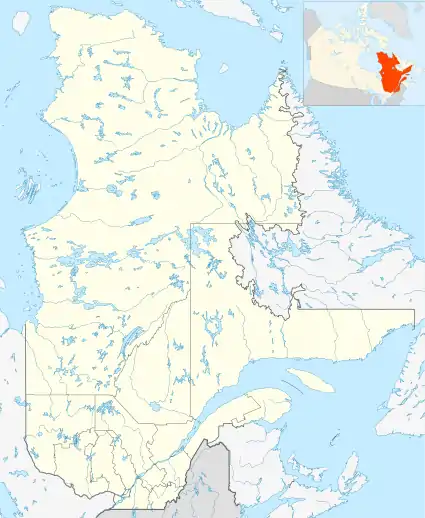Pakuashipi
Pakuashipi (or Pakua Shipi, or Pakua Shipu in Innu) is an Innu community in the Canadian province of Quebec, located on the north shore of the Gulf of Saint Lawrence in the Côte-Nord region. It is on the western shore of the mouth of the Saint-Augustin River, opposite the settlement of Saint-Augustin. It is not a reserve, but a community within the Municipality of Saint-Augustin, occupied by the Innu band of Pakua Shipi. Although they hold no formal legal title to the land at this time, negotiations are still ongoing to determine their aboriginal rights.
Pakuashipi
Pakua Shipu | |
|---|---|
 Pakuashipi | |
| Coordinates: 51°13′49″N 58°40′18″W[1] | |
| Country | |
| Province | |
| Region | Côte-Nord |
| RCM | Le Golfe-du-Saint-Laurent |
| Established | 1971 |
| Government | |
| • Chief | Denis Mestenapeo |
| • Federal riding | Manicouagan |
| • Prov. riding | Duplessis |
| Area | |
| • Land | 3.89 km2 (1.50 sq mi) |
| Population (2011)[3] | |
| • Total | 312 |
| • Density | 80.2/km2 (208/sq mi) |
| • Change (2006–11) | |
| • Dwellings | 87 |
| Time zone | UTC-4 (AST) |
| Postal Code | G0G 2R0 |
| Area code(s) | 418 and 581 |
The community is serviced by a health centre, a community centre, a church, a school, a community store, a youth centre, a community radio station, an inn, municipal water and sewer system, fire station, and an aboriginal police force.[2]
Pakuashipi is the Innu name of the Saint-Augustin River and means "shallow river", from pakua ("drained" or "dried up") and shipi ("river"). The inhabitants of this settlement are identified by other Innu groups as the Pakua-shipiunnuat, and are considered the most traditional, the most conservative Innu band, in terms of both culture and language.[4]
History
The area was originally home to nomadic Innu and Inuit tribes. Most of them, however, were displaced once Europeans began to exploit the area. In July 1949, the Quebec Government offered to the Innu population land with an area of 1.3 hectares (3.2 acres) in order to create a reserve. But this was refused by the federal government who deemed its population too small to justify such a decision. In the early 1960s, in order to provide essential services, the federal government decided to incorporate the Saint-Augustin group with the band at La Romaine reserve and relocated them there. But during the night, in a storm, the group returned to their ancestral land.[4]
On June 4, 1971, the Québec Ministry of Lands and Forests authorized the Government of Canada to build houses for the Indians of Saint Augustin on the current site. On July 27, 1987, the Saint Augustin Band changed its name to "Pakua Shipi Montagnais Band".[5]
Demographics
As of December 2009, the band counted 322 members, of which 320 persons are living in the community.[2] The number of private dwellings occupied by usual residents is 65 out of a total of 76. Mother tongues spoken are as follows:[6]
- English as first language: 0%
- French as first language: 5.2%
- English and French as first language: 0%
- Other as first language: 94.8%
Population trend:[7]
- Population in 2006: 289 (2001 to 2006 population change: 26.8%)
- Population in 2001: 228
- Population in 1996: 242
- Population in 1991: 211
Education
There is only one school on the reserve, École Pakuashipish, that provides pre-Kindergarten to Secondary grade 4, and had an enrollment of 88 students in 2008-2009.[2]
References
- "Pakuashipi". Geographical Names Data Base. Natural Resources Canada. Retrieved 2010-10-06.
- "Pakua Shipi First Nation". Aboriginal Community profiles. Indian and Northern Affairs Canada. Archived from the original on 2011-06-13. Retrieved 2010-09-27.
- Statistics Canada 2011 Census - Pakuashipi census profile
- "Pakuashipi (Établissement amérindien)" (in French). Commission de toponymie du Québec. Retrieved 2010-09-27.
- Natural Resources Canada - Legal Surveys Division, Historical Review - Saint-Augustin land title history Archived 2011-07-06 at the Wayback Machine
- Statistics Canada 2006 Census - Pakuashipi community profile
- Statistics Canada: 1996, 2001, 2006 census
- "Topographic Map sheet 12O2". Atlas of Canada. Natural Resources Canada. 2010-02-04. Retrieved 2010-10-06.

